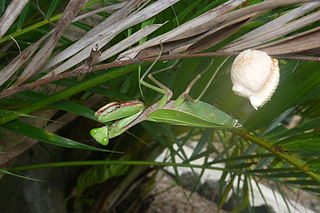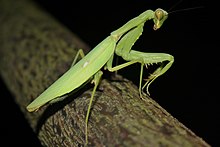
Mantidae is one of the largest families in the order of praying mantises, based on the type species Mantis religiosa; however, most genera are tropical or subtropical. Historically, this was the only family in the order, and many references still use the term "mantid" to refer to any mantis. Technically, however, "mantid" refers only to members of the family Mantidae, and not the 14 remaining families of mantises. Some of the most recent classifications have promoted a number of the mantid subfamilies to the rank of family, e.g. Iridopterygidae, Sibyllidae, Tarachodidae, Thespidae, and Toxoderidae, while other classifications have reduced the number of subfamilies without elevating to higher rank.

Tenodera is a genus of mantis in the family Mantidae which contains several species of praying mantises. The species in this genus can be found primarily in Africa, Asia and Australia, but also North America.

Hymenopus coronatus is a mantis from the tropical forests of Southeast Asia. It is known by various common names, including walking flower mantis, orchid-blossom mantid and (pink) orchid mantis. It is one of several species known as flower mantids, a reference to their unique physical form and behaviour, which often involves moving with a “swaying” motion, as if being “blown” in the breeze. Several species have evolved to mimic orchid flowers as a hunting and camouflaging strategy, “hiding” themselves in plain view and preying upon pollinating insects that visit the blooms. They are known to grab their prey with blinding speed.
Hierodula membranacea is a large praying mantis, sharing its common name giant Asian mantis with other large members of genus Hierodula: of which it is the type species. Its colours vary from green to yellow-green, or even brown to reddish-brown, similar to those of the giant Indian mantis and the giant Malaysian mantis. As the name suggests, it originates from south-eastern Asia and is among the largest of mantises. Male and female adults reach around 7–9 centimetres (2.8–3.5 in), excluding extended forelegs. It is a cannibalistic species, with the females sometimes eating the males after mating.
Titanodula grandis, also known as the giant Asian mantis, is a species of praying mantis native to the region around the Bay of Bengal in southern Asia. It is found in north-eastern India, Bangladesh, and Myanmar. It is a large mantis which grows up to 4 inches long.

Hierodula patellifera, common name giant Asian mantis, Asian mantis, Indochina mantis or Harabiro Mantis, is a species of praying mantis belonging to genus Hierodula.

Brunneria is a genus of praying mantises in family Mantidae. They are often called stick mantis for their slender shape and the species of the genus are native to the Americas.

Stagmomantis limbata, common name bordered mantis, bosque mantis, Arizona mantis, or New Mexico praying mantis, is a species of praying mantis native to North America, most prevalent in the south-western United States. This beneficial insect is green or beige in color and grows up to around 3 inches long.

Sphodromantis is a large genus of praying mantises concentrated in Africa, sometimes considered a synonym of the genus Hierodula: from the same tribe, Paramantini. Outside their range especially, many share the common name African Mantis.

The Chinese reddish mantis is a species of praying mantis in the family Mantidae.

Titanodula formosana is a species of praying mantis in the subfamily Hierodulinae. T. formosana is found in Taiwan, Malaysia and the Sunda islands.
Titanodula fruhstorferi is a praying mantis species in the subfamily Hierodulinae.

Hierodula majuscula is a species of praying mantis in the genus Hierodula. It is also known as the giant rainforest mantis and the Australian giant mantis. It is found in coastal northern Australia, usually in rainforest and adjacent habitats. This species is typically green although a less common bright yellow form does occur.

Hierodula tenuidentata is a species of praying mantis, sharing its common name giant Asian mantis with other large members of genus Hierodula in the family Mantidae. It is native to India, and has been introduced to Greece.

Mantises are an order (Mantodea) of insects that contains over 2,400 species in about 460 genera in 33 families. The largest family is the Mantidae ("mantids"). Mantises are distributed worldwide in temperate and tropical habitats. They have triangular heads with bulging eyes supported on flexible necks. Their elongated bodies may or may not have wings, but all Mantodea have forelegs that are greatly enlarged and adapted for catching and gripping prey; their upright posture, while remaining stationary with forearms folded, has led to the common name praying mantis.
Giant mantis may refer to:

Chordodes formosanus is a horsehair worm that has the praying mantis as its definitive host. Horsehair worms are obligate parasites that pass through different hosts at various stages. These worms can grow up to 90 cm long and can be extremely dangerous for their host, especially the praying mantis.

The Hierodulinae are a subfamily of praying mantids, originally used by Brunner von Wattenwyl. It was restored as part of a major revision of mantid taxonomy, and now contains genera previously placed elsewhere in the family Mantidae.

Titanodula is a genus of mantids in the subfamily Hierodulinae. There are currently five species placed in Titanodula. The genus is endemic to Asia and is distinguished from the similar genus Hierodula by the large size and unique male genitalia of its member species.



















